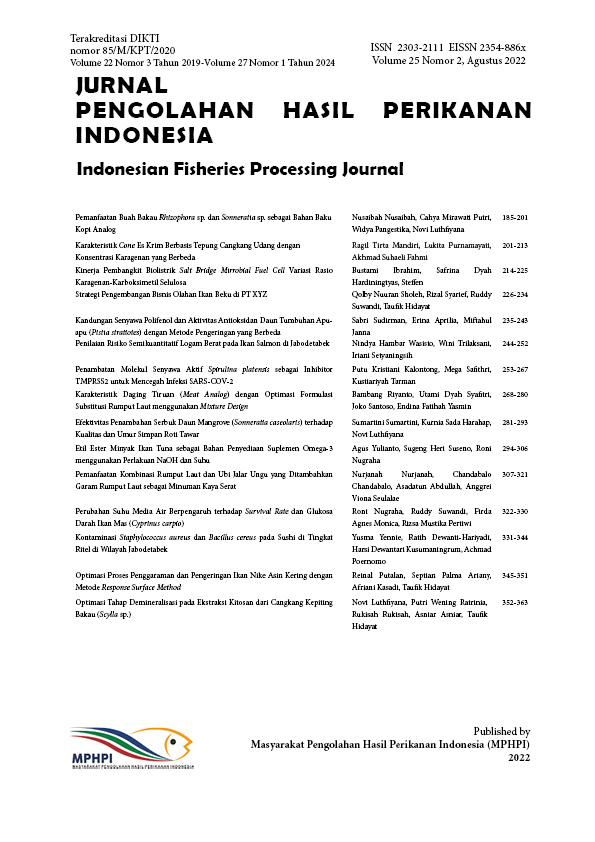Strategi Pengembangan Bisnis Olahan Ikan Beku di PT XYZ Frozen Fish Processing Business Development Strategy at PT XYZ
Abstract
The development of frozen food production in Indonesia have a significant increase in demand during the COVID-19 pandemic situation. This development is in line with the increasing demand for Indonesian seafood frozen, which are now getting more added value from the community. The development of the fish processing business has high potential to be developed, considering the ease of obtaining, storing and serving to serve as an additional side dish in the daily life. The research objectives are to analyze the internal and external factors of PT XYZ processed fish, formulating alternative business development strategies of PT XYZ, determining the priority of the policy strategy for the business development of PT XYZ. Descriptive research method, processed and analyzed using IFE, EFE, IE, SWOT and QSPM matrices. The results showed that there were raw material fo frozen is swangi fish. In addition, 7 alternative strategies including selling products to sole distributors, producing frozen fresh seafood, adding distributors outside East Java, increasing branding, processing fish into minced fish, and campaigning for fish as a source of protein. The priority resulting from the research is producing export grade frozen fresh seafood as a new product to be the most priority alternative that can be done by the company. So hopefully PT XYZ not only selling products in the domestic market, but the international market becomes an opportunity for the company.
References
Abbassi, F., Esparcia, J., & Saadi, H. A. (2019). From analysis to formulation of strategies for farm advisory services (case study: Valencia–Spain) an application trough swot and qspm matrix. European Countryside. 11(1), 43-73.
Alfarisi, M. N., Anggraeni, D., & Sariyoga, S. (2018). Strategi pengembangan produk olahan ikan lele (Clarias sp.) (suatu kasus di UKM Mae Shetie dan UKM abon ikan lele Kota Cilegon). Jurnal Agribisnis Terpadu. 11(1), 68-79.
Anggraeni, D., Nurjanah, Asmara, D. A., & Hidayat, T. (2019). Kelayakan industri pengolahan ikan dan mutu produk UMKM pindang tongkol di Kabupaten Banyuwangi. Jurnal Pengolahan Hasil Perikanan Indonesia. 22(1), 14-23.
David, F. R., & David, F. R. (2015). Strategic Management Concept and Cases. Fifteenth Edition. Pearson Education Inc.
David, F. R. (2011). Strategic Management: Concept and Cases. Thirteenth Edition.Pearson Education Inc.
Huli, L., Suseno, S. H., & Santoso, J. (2014). Kualitas minyak ikan dari kulit ikan swangi. Jurnal Pengolahan Hasil Perikanan Indonesia. 17(3), 233-242.
Kementerian Kelautan dan Perikanan. (2020). Laporan Tahunan Kementrian kelautan dan perikanan 2019.
Nurjanah, Suseno, S. H., Hidayat T, Paramuditha, P. S., Ekawati, Y., & Arifianto, T. B. (2015). Changes in nutritional composition of skipjack (Katsuwonus pelamis) due to frying process. International Food Research Journal. 22(5), 2093-2102.
Rangkuti. (2014). Teknik Membedah Kasus Bisnis: Analisis SWOT (Cara Perhitungan Botot, rating, dan OCAI). PT Gramedia Pustaka Utama.
Riset Kesehatan Dasar. (2018). Laporan Nasional Riset Kesehatan Dasar (RISKESDAS) 2018. http:www.kemkes.go.id.
Dewi, P. F, A., Widarti, I. G. A, & Sukraniti, D. P. (2018). Pengetahuan ibu tentang ikan dan pola konsumsi ikan pada balita di desa kedonganan kabupaten bandung. Journal of Nutrition Science. 7(1), 16-20.
Rosari, M. I., Ma’aruf, W. F., & Agustini, T. W. (2014). Pengaruh ekstrak kasar buah mahkota dewa (Phaleria macrocarpa) sebagai antioksidan pada fillet ikan bandeng (Channos channos). Jurnal Pengolahan dan Bioteknologi Hasil Perikanan. 3(2), 34-43.
Rumokoy. (2017). Indonesian north bolaang mongondow’s furniture industry – QSPM and topsis model. Journal of ASEAN Studies Maritime Issues. 3(4), 1 -18.
Zulkarnain, A., Wahyuningtias, D., & Putranto, T. S. (2018). Analysis of IFE, EFE and QSPM matrix on business development strategy. IOP conf. Series: Earth and Environmental Science. 126 (1).
Authors

This work is licensed under a Creative Commons Attribution 4.0 International License.
Authors who publish with this journal agree to the following terms:
- Authors retain copyright and grant the journal right of first publication with the work simultaneously licensed under a Creative Commons Attribution License that allows others to share the work with an acknowledgement of the work's authorship and initial publication in this journal.
- Authors are able to enter into separate, additional contractual arrangements for the non-exclusive distribution of the journal's published version of the work (e.g., post it to an institutional repository or publish it in a book), with an acknowledgement of its initial publication in this journal.





